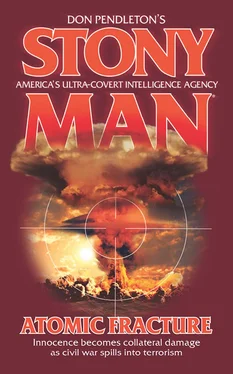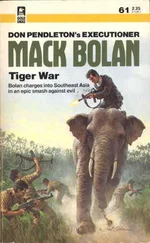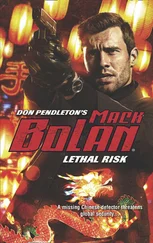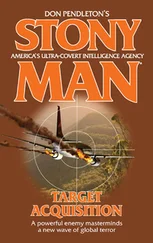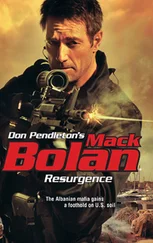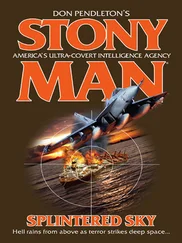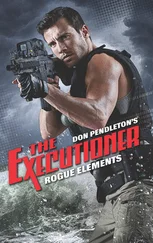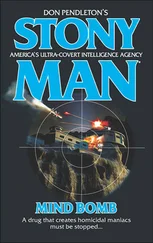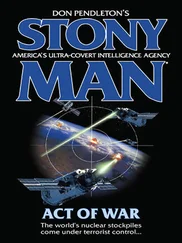McCarter fired another burst, then dropped to his knee again behind the abandoned jeep. Following the time-proven strategy that you never showed yourself to the enemy more than once in the same place, he knee-walked his way to the right bumper. Leaning his face around the edge, he kept the rest of his body behind the vehicle and extended the LAR-15 at arm’s length. His body still completely covered, he risked only his hands and arms as he used his thumb on the trigger, firing a long full-auto burst blindly in the general direction of the enemy.
McCarter jerked his arms and the rifle back out of sight, immediately edging his face around the jeep’s bumper. His blind assault had done the job he’d wanted it to do, causing the enemy combatants to shrink back into hiding long enough for him to make a quick survey of the situation.
One man, however, had not been intimidated by the full-auto blast. He had dark skin and wore a bright red shirt that looked as if the sleeves had been chopped off at the shoulders with a machete. McCarter switched the selector on his LAR-15 to 3-round burst and squeezed the trigger again, this time with his eyes fixed on the center of the man’s chest.
Black holes appeared in the red cloth of his shirt as the man danced like a marionette on the end of the strings of a mad puppeteer. As he fell to the ground, another attacker—this one wearing blue jeans and a white T-shirt—caught more rounds from one of the other Phoenix Force men. The AK-47 in the man’s hands flew up into the air as one of the hollowpoints apparently hit a nerve, causing his arm to rise. Red blotches appeared on the white shirt—two in the chest and one in the shoulder—as he joined his red-clad comrade in death.
Blood seeping from the bullet wounds in the red shirt had made black splotches. In the white shirt, the holes had turned red. But white or red, either way, someone needed to teach these attackers something about camouflage. Red and white did little for concealment in an environment made up of green-and-brown vegetation and rusted-out vehicles.
McCarter took a deep breath as the firing around him continued. As safe as could be expected behind the old jeep’s engine block, his eyes flashed 180 degrees through the tall grass in the vacant spaces of this automobile graveyard. As was the case in so many Third World countries, vehicles so old or used that no American would have them anymore had been shipped to Radestan. Here, locals had brought them back to life using everything from home-manufactured replacement parts to bailing wire in an effort that was, ironically, called “Yankee Ingenuity.” But even the work of such desperate mechanics had its limits, and eventually the scraps had been abandoned.
McCarter caught himself shaking his head in dismay. It seemed that everywhere he looked he saw a make and model of automobile he had not seen since he’d been a child. Other vehicles had ceased being produced before he had even been born.
As he prepared to lean around the jeep and fire again, the Phoenix Force leader saw James rise slightly behind the remnants of a 1965 Dodge Dart GT. A few spots of gold paint could still be seen on the old car’s body but ninety percent of the vehicle now sported nothing but gray primer. James’s big Crossada was back in the sheath on his hip, and the former Navy SEAL was leaning over the GT’s hood with his LAR-15. Sputtering 5.56 mm rounds through the barrel, the Hunter danced slightly in his hands as he fired a full-auto stream across the car at some target that was out of McCarter’s vision.
Dave McCarter’s attention was focused so intently on the enemies in the tall grass in front of him that he almost missed the crunching sound of footsteps to his rear. But instinct and training took over, and before he even realized what he was doing he had whirled around. Still on his knees, McCarter caught a glimmer of blue through the brown-and-yellow stalks behind him. And in less time than it would have taken to write it up in a report, he knew that no one on his team, nor Abdul Ali, had been clad in anything blue.
His finger pulled back on the trigger.
McCarter’s Rock River rifle choked out rounds and a trio of hollowpoints disappeared into the grass. He heard a low, guttural grunting sound, then the fleck of blue descended beneath the dead foliage. As the explosions from the AK-47s and Phoenix Force’s LAR-15s died down, the former British SAS man slung his rifle across his back, drew his Browning Hi-Power and crawled forward.
By the time he reached the body with the blue T-shirt, the gunfire had stopped completely. Behind him now, McCarter could hear the quiet chatter of his own men. They were moving slowly through the grass and around the abandoned vehicles, checking to make sure there were no survivors to “pop back to life” and kill them.
The man in blue who had crept toward the Phoenix Force leader from the rear had been gut-shot, then fallen facedown in the mud. McCarter had to have passed by him to the side as he’d moved forward. But the shooter had gone unseen in the underbrush. At some point, he’d regained enough strength to rise and attack from the rear.
The Phoenix Force leader knelt and checked him out closer now. An exit hole the size of a softball gaped upward from between the man’s shoulder blades. Multicolored masses of flesh, blood and bone had exited and some of it still lay on the man’s back as if dumped there. The Phoenix Force leader reached down, grabbed the shooter’s shoulder and rolled him over onto his back. He frowned slightly as he saw that two of the three rounds he had fired at the grass-hidden blue seemed to have missed.
But that didn’t matter much. One bullet had found its mark dead center in the middle of the T-shirt. It was far smaller than the one in the dead man’s back, as was to be expected for an entry wound. But between the two holes in the man’s body, the 5.56 mm hollowpoint had done its job.
The heart had to have been mangled beyond recognition.
The roar of the rifles on both sides of the skirmish was now a thing of the past. McCarter rose, turned around and walked back to join the rest of the men who had regrouped around an ancient Dodge Charger. “Everybody okay?” he asked.
Everyone nodded.
“Good,” said the Phoenix Force leader. “Then let’s get on in to Ramesh.” He paused and wiped the sweat off his brow with the back of his sleeve. “The real fighting’s about to begin.”
CHAPTER FOUR
Charlie Mott, Stony Man Farm’s second pilot, was almost as good with wings as Jack Grimaldi. At least he was good enough to get the men of Able Team from Stony Man Farm to Colorado Springs, Colorado, in what might well have been record time—even for a Learjet.
If the flight had been official. But of course it wasn’t. There would be no record of the trip since as far as the vast majority of the world knew it had never taken place. To everyone outside the Stony Man Farm family, except for the President of the United States, there wasn’t even an Able Team in existence. Just as there was no Mack Bolan or Phoenix Force or Stony Man Farm in general.
Carl “Ironman” Lyons, Able Team’s former LAPD detective, felt himself smile inwardly. In a weird way, the whole Stony Man Farm crew—Mack Bolan, the teams, the blacksuits and the specialized computer, forensic and other support staff—reminded Lyons a bit of J. Edgar Hoover’s attempt to convince the public that there was no such thing as the Mafia. Of course there were three major differences.First, the now deceased FBI director’s nonexistent Mafia had boot-legged countless gallons of illegal liquor, then billions of dollars of illegal narcotics throughout the country. And they’d been responsible for more murders than could be counted. But Hoover’s propaganda had been put out over a half century earlier—at a time when the general public still had at least a little faith that some politicians were honest. Faith in politicians—be they Democrat or Republican, conservative or liberal—had all but vanished in recent years.
Читать дальше
